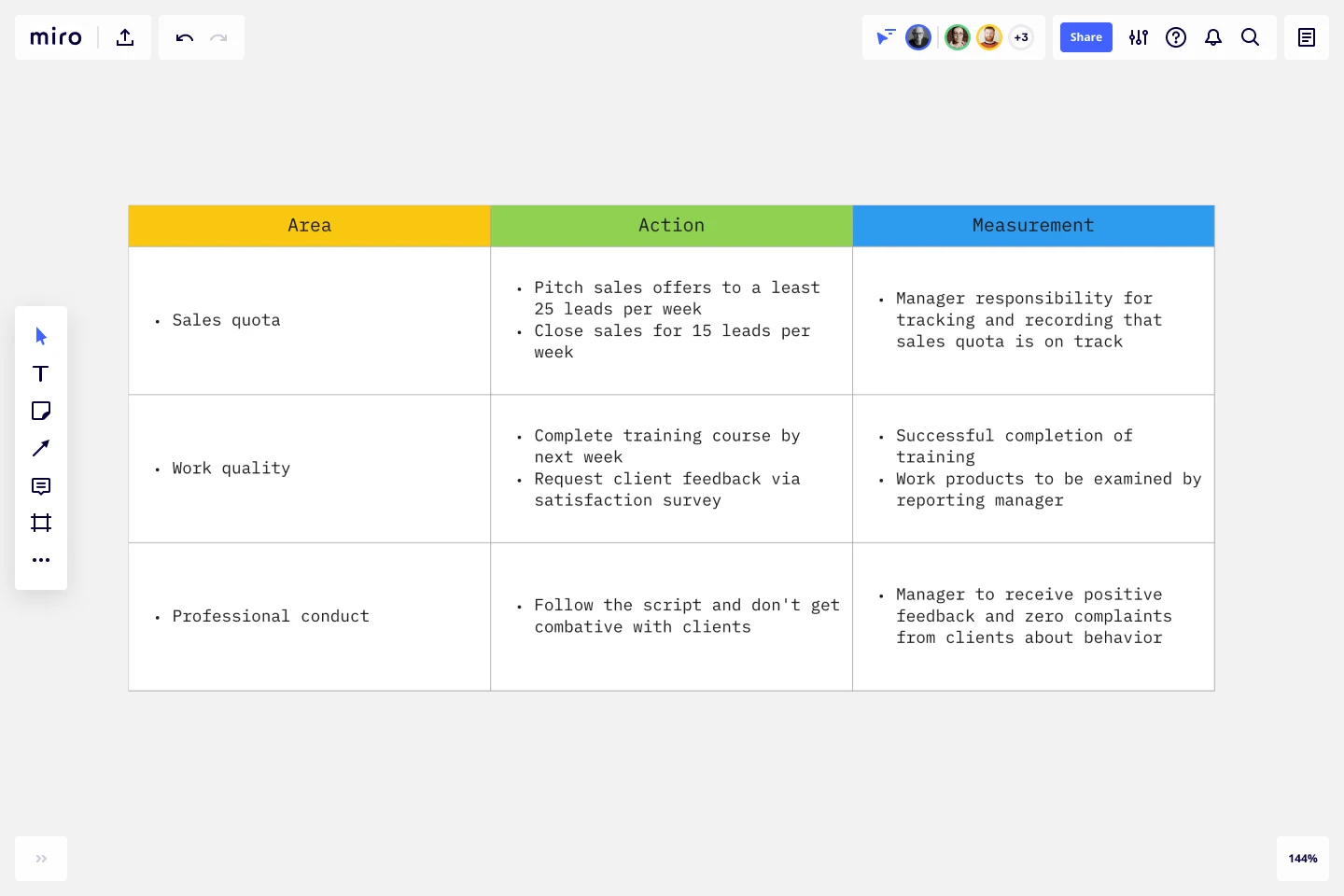Corrective Action Plan Template
Correct for any undesirable actions, outcomes, or behaviors that occur in the workplace. Document everything in a written framework with actionable steps using Miro’s template for corrective action.
Trusted by 65M+ users and leading companies
About the Corrective Action Plan Template
Once in a while, a manager or HR representative must deliver a corrective action plan to an employee. It’s a difficult conversation, but when inappropriate behavior occurs or job performance fails to meet expectations, the best course of action is to document the infraction. Not only does it help drive the conversation between HR, the manager, and the employee, but it also paves the way for actionable next steps for improvement.
Keep reading to learn more about how to use this simple Corrective Action Plan Template.
What is a corrective action plan?
A corrective action plan takes difficult conversations — regarding behavior or job performance — and puts them into a professional, written framework so that the process, next steps, and details of the conversations are documented. A corrective action plan might include the following:
A write-up of the deficiency (behavioral or performance) and why it has created a disconnect in the expectations of the role.
An HR-approved template describing what is included in the corrective action plan and what steps must be followed.
A process of stop, start, and continue is clearly laid out.
Clarification of roles & responsibilities.
A specification of the ramifications of not following the corrective action plan.
This might seem like a lot of work for a manager or HR team member, but that’s why having an easy-to-use template is just what you need to simplify the tasks!
When to use corrective action plans
Corrective action plans aren’t always negative in nature. Sure, the most common use case might be combating behavior issues, but corrective action can also signal the need for sweeping changes within an organization or team. Put more simply: corrective action can be looked at like quality assurance within individuals or teams that pinpoints a problem, then sets out to fix a specific behavior, task, process, or product.
Create your own corrective action plan
When it comes to corrective action plans, the most important thing is eliminating murky communication, aligning expectations, and providing step-by-step instructions for your employee. Here’s how to create your own, using Miro’s easy pre-made corrective action plan template.
Set a deadline. Set a deadline for completing the steps for corrective action. Also make sure you clearly outline the consequences for not meeting the deadline.
Set priorities and realistic goals: Whether this is an action plan for an individual or a team, setting yourself up for success means setting up priorities and goals.
Document everything: Stakeholders, metrics, dates, expected resolution. Everything should be carefully documented so you have a record of the action plan.
Define the problem! Every corrective action plan must first start with a problem that must be addressed. Make sure you write this down.
Get started with this template right now.
Service Blueprint by Liz Possee Corthell
Works best for:
Service Blueprint
Enhance your service design with the Service Blueprint Canvas. This template helps you visualize and analyze the entire service process, from front-stage customer interactions to back-stage support activities. Identify pain points, optimize workflows, and improve customer experiences. Ideal for service designers, managers, and teams focused on delivering exceptional service. The blueprint provides a comprehensive view, facilitating better communication and strategic planning.
UML Activity Diagram Template
Works best for:
Diagrams
Use our Activity Diagram template to break down activities into smaller decisions and subprocesses. Improve and optimize systems and processes in I.T., business management, and more.
Rose, Bud, Thorn Retrospective Template
Works best for:
Agile Workflows, Retrospectives
Run a simple yet effective retrospective with the Rose, Bud, Thorn Retrospective Template. Identify positive outcomes, challenges, and opportunities moving forward.
Kudos Template
Works best for:
Team management
The Kudos Template boosts team morale by providing a structured platform for team members to recognize and celebrate achievements. It fosters a positive environment of appreciation, respect, and unity.
Entity–Relationship Diagram (ERD) HR Management System Template
Works best for:
ERD
The Entity–Relationship Diagram (ERD) HR Management System Template in Miro is designed to streamline the management of employee-related information and processes within an organization. This template allows for the visualization and organization of complex HR systems, making it easier to understand relationships and processes. It enables users to map out departments, positions, and employee details, including attendance records, payroll, and performance reviews.
Flyer Maker Template
Works best for:
Design, Marketing
Whether it’s a client party or a nonprofit fundraiser, your event needs one key thing to be a smashing success: people to show up. That’s why promoting it is such an important part of the planning—and creating and sending a flyer is the first step. These single-page files will grab your guests’ attention and give them the key details, such as the time, date, and location (and if it’s a fundraiser, who/what the funds will benefit). This template will let you lay out text and customize a flyer design.
